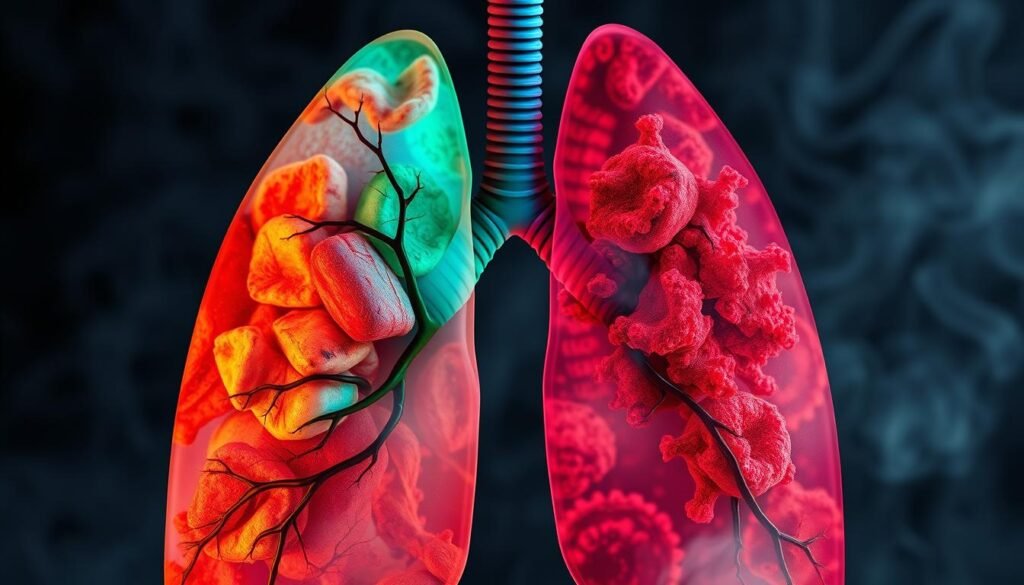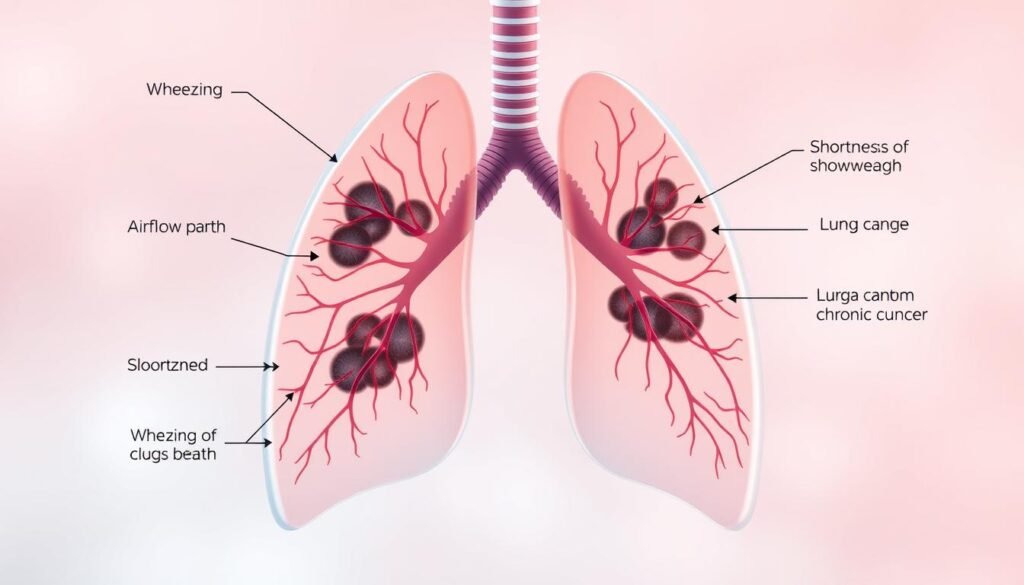About 80 percent of lung cancer patients also have Chronic Obstructive Pulmonary Disease (COPD). This fact shows how these two serious lung illnesses are connected. It’s crucial to know the risks and symptoms of each. COPD and lung cancer mostly impact lung health. Yet, their symptoms can overlap. This makes figuring out and treating these conditions tricky.
This article explores what life is like with these illnesses. It stresses the need to spot signs of COPD lung cancer early. Understanding COPD symptoms and their link to lung cancer helps in taking early action for health. Knowing about this connection might raise awareness and lead to early spotting of the disease. This could make treatments more effective.
Key Takeaways
- Understanding the connection between COPD and lung cancer is vital for effective health management.
- Recognizing overlapping symptoms can expedite diagnosis and treatment.
- Individuals with COPD are at a significantly higher risk of developing lung cancer.
- Statistical insight reveals the prevalence of co-occurrence of these two conditions.
- Proactive health management can influence treatment outcomes and quality of life.
Introduction to COPD and Lung Cancer
Chronic obstructive pulmonary disease (COPD) and lung cancer are major health issues. COPD affects around 251 million people globally. It leads to a spending of about $929 million every year in Australia. This condition is mainly caused by chronic bronchitis and emphysema, which block the lungs over time.
Lung cancer is the top cause of cancer-related deaths. It accounts for one-fifth of all cancer deaths around the world. By 2030, the number of deaths from lung cancer could reach an alarming 10 million annually. Despite a low five-year survival rate of 16%, knowing its link to COPD is crucial for health.
People with COPD have a higher chance of getting lung cancer, up to six times more likely. This risk is there regardless of their smoking status, age, or gender. The increased risk from environmental toxins like asbestos or radon, and using biomass fuels, is also critical to note.
It’s important to understand both COPD and lung cancer well. This knowledge helps in creating ways to prevent them. Since COPD might become the third leading cause of death by 2030, raising awareness is key. Early detection and taking action early can help in fighting these serious health issues.
| Health Issue | Global Statistics | Projected Trends |
|---|---|---|
| Chronic Obstructive Pulmonary Disease | Affects 251 million people worldwide, 8-10% of adults in developed nations | Projected to be the 3rd leading cause of death by 2030 |
| Lung Cancer | Accounts for 20% of cancer deaths worldwide, 5-year survival rate is 16% | Estimated 10 million deaths per year by 2030 |
| Risk Factors | Smoking, environmental toxins, indoor air pollution | Increased risk of lung cancer in individuals with COPD by 4-6 times |
What is Chronic Obstructive Pulmonary Disease (COPD)?
Chronic Obstructive Pulmonary Disease, known as COPD, includes progressive breathing issues. It involves conditions like emphysema and chronic bronchitis. Knowing the symptoms early on helps manage it better.
Definitions and Symptoms
COPD makes it hard to breathe because airflow is limited. People with COPD often have:
- Chronic cough
- Excessive sputum production
- Wheezing
- Shortness of breath, especially during physical activities
If COPD gets worse, it’s crucial to see a doctor soon. COPD combines different lung conditions that worsen over time.
Types of COPD: Emphysema and Chronic Bronchitis
Knowing about emphysema and chronic bronchitis helps treat COPD. Emphysema damages lung air sacs, making it hard to breathe. Chronic bronchitis means the airways are inflamed, causing coughs and mucus. Both are key parts of COPD and need specific treatments.
| Type of COPD | Definition | Common Symptoms |
|---|---|---|
| Emphysema | Damage to alveoli, resulting in reduced oxygen transfer. | Shortness of breath, fast breathing. |
| Chronic Bronchitis | Inflammation of bronchial tubes causing mucus production. | Persistent cough, excess mucus. |
Understanding Lung Cancer: Types and Statistics
Lung cancer comes in different types, key to deciding on treatments. The main kinds are non-small cell lung cancer (NSCLC) and small cell lung cancer (SCLC). SCLC is rarer and usually caused by smoking. This shows how smoking affects lung cancer rates.
Non-Small Cell and Small Cell Lung Cancer
About 80% of lung cancers are NSCLC, which includes:
- Adenocarcinoma: Often in the lung’s outer areas.
- Squamous cell carcinoma: Found near the bronchus, leading into the lungs.
- Large cell carcinoma: Spreads faster than other NSCLC types.
- Pancoast tumors: A rare NSCLC, growing in the lung’s top part.
Small cell lung cancer is about 15% of cases. It grows quickly and often has worse outcomes. Knowing these types helps with prognosis and treatment choices.
Lung Cancer Statistics and Survival Rates
Lung cancer is a top cause of cancer deaths worldwide. Its 5-year survival rate is around 16%. Survival chances differ by cancer type and stage when found. Smoking is a main cause, affecting incidence rates. Other risks include secondhand smoke, past radiation, and various environmental factors.
Knowing these facts stresses the need for early detection and lifestyle changes. These steps can lower lung cancer risks.
The Connection Between COPD and Lung Cancer
It’s important to understand the COPD lung cancer link. They share many features. COPD greatly boosts the chance of getting lung cancer. Specifically, small cell lung cancer which makes up 15% of cases worldwide. People with COPD are twice as likely to get lung cancer than those without it.
These illnesses share common causes like smoking. Smoking is a big reason for COPD in countries like the U.S. COPD can also lead to chronic inflammation. This harms lung tissue and may cause cancerous changes. So, many lung cancer patients have had COPD before.
Noticing similar symptoms is key. Symptoms like feeling very tired, not wanting to eat, and chest pain might mean COPD or cancer. Spotting these early helps a lot in treatment. Using tools like a Lung Aware Risk Assessment is wise for lung health concerns.
Lung cancer is a top killer, with a 5-year survival rate of just 16%. As COPD becomes more common, especially among smokers, understanding the COPD lung cancer link is urgent.
| Condition | Risk of Lung Cancer Development | Common Risk Factors |
|---|---|---|
| COPD | Twice as likely compared to non-COPD individuals | Smoking, environmental toxins |
| Lung Cancer | Common among individuals with COPD | Shared risk factors like smoking |

Boosting awareness about these conditions leads to better prevention and treatment. Early medical advice is key for those at risk. This highlights the need to recognize the shared risk factors between COPD and lung cancer.
Risk Factors Contributing to COPD Lung Cancer
Knowing the risk factors for COPD and lung cancer is crucial. Smoking is a big risk, but environment and genes also matter.
The Role of Smoking in Disease Development
Smoking is the top risk for both COPD and lung cancer. Around 80% of lung cancer deaths are due to smoking. Smokers are much more likely to get these diseases than non-smokers.
Stopping smoking is the best way to reduce your risk. Tobacco smoke causes oxidative stress and DNA damage. This can lead to both diseases.
Environmental and Genetic Factors
There are other risks besides smoking. Air pollution, secondhand smoke, and workplace toxins like asbestos raise the risk. Some genetic conditions, like alpha-1-antitrypsin deficiency, also play a role.
If you have lung cancer in your family, your risk might be higher. For more information, visit what causes COPD.
Symptoms Commonly Associated with COPD and Lung Cancer
COPD and lung cancer often have similar symptoms. Spotting these symptoms early is crucial for medical care. People with COPD symptoms like long-lasting coughs, wheezing, and trouble breathing should see a doctor. This early action helps manage breathing issues and might spot lung cancer early.
Overlapping Symptoms: Coughing, Wheezing, and Shortness of Breath
Patients with COPD symptoms may report coughing, wheezing, and breathlessness. These can be confused with lung cancer symptoms. Such confusion can lead to misdiagnosis or delayed treatment. Knowing these conditions share symptoms encourages seeking medical advice early.
Specific Symptoms Indicating Lung Cancer
Besides common symptoms, some signs might point to lung cancer. Important lung cancer symptoms are ongoing chest pain, unexpected weight loss, and coughing up blood. Spotting these signs early is key for quick diagnosis and better treatment results. Watching for these symptoms can greatly impact the health and survival of those at risk. For further details on these conditions, visit this helpful article.

Diagnosis of COPD and Lung Cancer
Diagnosing COPD and lung cancer needs a detailed approach. Doctors use different tests and methods to check for these illnesses. Finding them early can greatly help in treatment and improve the chances of getting better.
Methods Used for Diagnosis
For COPD, doctors look at the patient’s health history and do physical exams. They also use lung function tests like spirometry to see how much the airflow is blocked. When checking for lung cancer, CT scans and PET scans are very important. These scans show if there’s anything wrong in the lungs.
If there’s a chance of lung cancer, biopsies may be needed. This is when a small piece of tissue is taken to look for cancer cells.
Importance of Early Detection
Finding COPD and lung cancer early is key to managing them well. If you have symptoms like a long-lasting cough or losing weight without trying, you should see a doctor. Getting diagnosed early with lung cancer means a better chance of success in treatment.
Handling COPD well can also lower the risk of getting lung cancer later. That’s why it’s important for people at high risk to get checked often.
| Diagnostic Tests | Purpose | Associated Prognosis |
|---|---|---|
| Lung Function Tests | Assess airflow limitation in COPD | Helps in determining COPD prognosis |
| CT Scans | Visualize lung abnormalities | Key for lung cancer diagnosis |
| Biopsies | Confirm presence of cancerous cells | Essential for assessing lung cancer prognosis |
Treatment Options for COPD and Lung Cancer
To manage COPD and lung cancer well, a mix of treatments is used. It’s key to know these options to improve health.
COPD Management Strategies
COPD’s treatment aims to ease symptoms and slow the disease. Among the management strategies are:
- Medications: Bronchodilators like Albuterol and Ipratropium open airways. Inhaled corticosteroids lower inflammation. Sometimes, oral corticosteroids are used for brief times.
- Pulmonary Rehabilitation: These programs offer education, exercise tips, and diet advice. They help people handle their COPD better.
- Respiratory Therapy: Oxygen therapy and noninvasive ventilation can improve life quality and extend it.
- Lifestyle Modifications: Stopping smoking and getting active can greatly improve lung function and overall health.
Lung Cancer Treatments: Chemotherapy, Radiation, and Surgery
Lung cancer treatments vary by cancer type and stage and the patient’s health. Lung cancer treatment options include:
- Chemotherapy: Used after surgery to kill remaining cancer cells. It can also be used with radiation therapy.
- Radiation Therapy: Works for both localized and advanced lung cancer. It shrinks tumors and eases symptoms, often with chemotherapy.
- Surgery: Options range from removing a small part of the lung to taking out a whole lung, based on cancer spread.
- Targeted Therapy: This treatment targets cancer cells directly. It’s usually for more advanced cases.
- Immunotherapy: This boosts the immune system to fight cancer. It’s an option when surgery isn’t possible.

A team often works together to plan treatments. Regular check-ups and tweaking treatments ensure the best care for both COPD and lung cancer.
| Treatment Option | COPD | Lung Cancer |
|---|---|---|
| Medication | Bronchodilators, Inhaled Corticosteroids | Chemotherapy, Targeted Therapy |
| Therapy | Pulmonary Rehabilitation, Oxygen Therapy | Radiation Therapy |
| Surgery | Not Applicable | Wedge Resection, Lobectomy, Pneumonectomy |
| Supportive Care | Smoking Cessation, Nutritional Advice | Palliative Care |
Potential for Lung Cancer Prevention in COPD Patients
People with Chronic Obstructive Pulmonary Disease (COPD) have a high chance of getting lung cancer. Stopping smoking and making key lifestyle changes are ways to prevent lung cancer. These steps help improve lung health and lower cancer risks.
Smoking Cessation and Lifestyle Changes
For COPD sufferers, the most important action is to stop smoking. Research shows those who stop smoking greatly lower their lung cancer risk. Quitting smoking, with the help of support programs, boosts success rates.
Adding regular exercise and a healthy diet is also crucial. Both help keep the lungs healthy and decrease the risk of cancer.
Research on New Treatment Approaches
Current lung cancer research is key to finding better treatment methods for both COPD and lung cancer. It studies common links and possible treatments to improve COPD treatment advancements. New treatments, like genetic profiling and immunotherapy, are promising. They may lead to more effective care and better results for those facing both issues.
| Strategy | Description | Importance |
|---|---|---|
| Smoking Cessation | Quitting smoking to reduce cancer risk. | Critical for lung cancer prevention. |
| Lifestyle Changes | Implementing exercise and a balanced diet. | Supports overall lung health. |
| Supportive Programs | Assistance for individuals attempting to quit smoking. | Increases success rates in quitting. |
| Research on Treatment Approaches | Investigation into new therapies for COPD and lung cancer. | Potential for better management and outcomes. |
Conclusion
Knowing how COPD and lung cancer awareness are linked is key to good health care. Research shows that people with COPD are more likely to get lung cancer. This is true even if they’ve never smoked. That’s why it’s important to keep a close eye on those with chronic obstructive pulmonary disease.
Early detection and tailored treatments can make a big difference. Quitting smoking and treating COPD well can lower lung cancer risks. COPD is common in lung cancer patients, so fighting both can help improve life quality.
It’s vital to treat these diseases together and understand their connection. For more information, check out this link for details on managing these conditions. Raising awareness on COPD and its role in lung cancer can lead to better outcomes for affected individuals.